Section 5. Lateral Separation
- Views Views: 860
- Last updated Last updated:
-
Sub-pages:
Section 5. Lateral Separation
6-5-1. SEPARATION METHODS
Separate aircraft by one of the following methods:
- Clear aircraft on different airways or routes whose widths or protected airspace do not overlap.
- Clear aircraft below 18,000 to proceed to and report over or hold at different geographical locations determined visually or by reference to NAVAIDs.
- Clear aircraft to hold over different fixes whose holding pattern airspace areas do not overlap each other or other airspace to be protected.
- Clear departing aircraft to fly specified headings which diverge by at least 45 degrees.
6-5-2. MINIMA ON DIVERGING RADIALS
- Consider separation to exist between aircraft:
- Established on radials of the same NAVAID that diverge by at least 15 degrees when either aircraft is clear of the airspace to be protected for the other aircraft.
- With non-VOR/DME based navigational equipment established on tracks of the same waypoint that diverge by at least 15 degrees when either aircraft is clear of the airspace to be protected for the other aircraft.
FIG 6-5-1 Minima on Diverging Radials 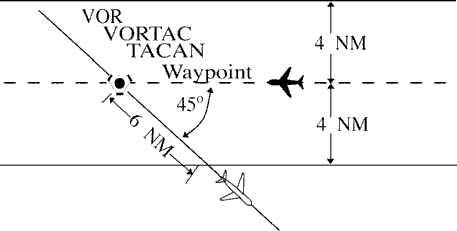
NOTE: The procedure may be applied to converging as well as diverging aircraft. (See FIG 6-5-1.) The aircraft depicted 6 miles from the NAVAID/waypoint would require vertical separation until reaching the 6-mile point. Reversing direction, the same aircraft would require vertical separation before passing the 6-mile point. Due to the nature of GPS equipment, issue crossing restrictions in reference to the next waypoint, since the pilot receives tracking “to” data rather than tracking “from” the last waypoint.
- Use TBL 6-5-1 and TBL 6-5-2 to determine the distance required for various divergence angles to clear the airspace to be protected. For divergence that falls between two values, use the lesser divergence value to obtain the distance.
TBL 6-5-1 Non-DME Divergence Distance Minima Divergence (Degrees) Distance (NM) 15 16 20 12 25 10 30 8 35 7 45 6 55 5 90 4 NOTE: This table is for non-DME application only. TBL 6-5-2 Divergence Distance Minima Divergence (Degrees) Distance (NM) Below FL 180 Fl 180 through FL 450 15 17 18 20 13 15 25 11 13 30 9 11 35 8 11 45 7 11 55 6 11 90 5 11 NOTE: This table is for DME application and compensates for DME slant-range error. NOTE: For altitudes of 3,000 feet or less above the elevation of the NAVAID, DME slant-range error is negligible and the values in TBL 6-5-1 may be used.
6-5-3. DME ARC MINIMA
Apply lateral DME separation by requiring aircraft using DME to fly an arc about a NAVAID at a specified distance using the following minima: (See FIG 6-5-2.)
FIG 6-5-2 DME Arc Minima 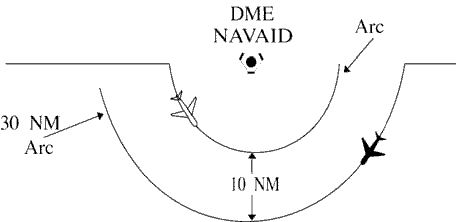
- Between different arcs about a NAVAID regardless of direction of flight:
- At 35 miles or less from the NAVAID- 10 miles.
- More than 35 miles from the NAVAID- 20 miles.
- Between an arc about a NAVAID and other airspace to be protected: (See FIG 6-5-3.)
FIG 6-5-3 DME Arc Minima 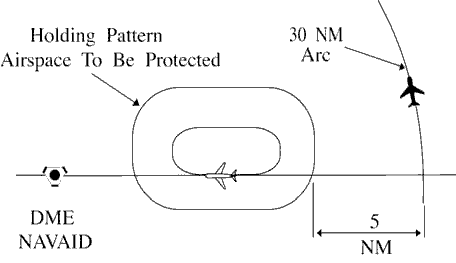
NOTE: The other airspace to be protected may be a MOA, a holding pattern, airway or route, ATCAA, Warning Area, Restricted Area, Prohibited Area, etc.
- At 35 miles or less from the NAVAID- 5 miles.
- More than 35 miles from the NAVAID- 10 miles.
- PHRASEOLOGY
- VIA (number of miles) MILE ARC (direction) OF (name of DME NAVAID).
6-5-4. MINIMA ALONG OTHER THAN ESTABLISHED AIRWAYS OR ROUTES
Protect airspace along other than established airways or routes as follows: (See FIG 6-5-4.)
FIG 6-5-4 Minima Along Other Than Established Airways or Routes - REFERENCE
- P/CG Term - Airway.
- P/CG Term - Route.
- Direct courses and course changes of 15 degrees or less:
- Via NAVAIDs or radials FL 600 and below- 4 miles on each side of the route to a point 51 miles from the NAVAID, then increasing in width on a 4 1/2 degree angle to a width of 10 miles on each side of the route at a distance of 130 miles from the NAVAID.
- Via degree-distance fixes for aircraft authorized under para 4-4-3, Degree-Distance Route Definition for
Military Operations.
- (a) Below FL180- 4 miles on each side of the route.
- (b) FL 180 to FL 600 inclusive- 10 miles on each side of the route.
- Via degree-distance fixes for RNAV flights above FL 450- 10 miles on each side of the route.
NOTE: Except for GNSS-equipped aircraft /G, /L, /S, and /V, not on a random impromptu route, Paragraph 5-5-1, Application, requires radar separation be provided to RNAV aircraft operating at and below FL450 on Q routes or random RNAV routes, excluding oceanic airspace.
- GNSS-equipped RNAV aircraft provided non-radar separation on random RNAV routes must be cleared via or
reported to be established on point-to-point route segments.
- (a) The points must be published NAVAIDs, waypoints, fixes, or airports recallable from the aircraft's navigation database. The points must be displayed on controller video maps or depicted on the controller chart displayed at the control position. The maximum distance between points must not exceed 500 miles.
- (b) Protect 4 miles either side of the route centerline.
- (c) Assigned altitudes must be at or above the highest MIA along the projected route segment being
flown, including the protected airspace of that route segment.
- EXAMPLE
- A pilot has filed a point-to-point route from XYZ to ABC at 13,000 feet. Departure procedures from the originating airport place the aircraft a significant distance from XYZ; however, the aircraft can establish itself along the route segment from XYZ to ABC. Ascertain when the pilot is established on the point-to-point route segment and at an altitude that meets or exceeds the highest MVA/MIA projected along the route of flight, then issue a clearance. “Verify when you are established on the XYZ to ABC route segment at or above 6,000 feet.”
- (d) When the GNSS aircraft is being provided radar service and is transitioning to non-radar airspace, provide clearance direct to the named point in non-radar airspace in accordance with subparagraphs a4(a) through (c).
- If transitioning between two random point-to-point routes, GNSS-equipped aircraft being provided non-radar
separation may be cleared via an impromptu route when the following conditions are met:
- (a) The impromptu route segment must not exceed the distance to the nearest available recallable fix/waypoint consistent with the direction of flight; and
- (b) Assigned altitudes must beat or above the highest MIA along the projected route segment being flown; and
- (c) Aircraft conducting the impromptu route must be separated vertically from other aircraft until established on the new point-to-point route.
- When course change is 16 degrees through 90 degrees, protect the airspace on the overflown side beginning at the
point where the course changes as follows: (See FIG 6-5-5.)
FIG 6-5-5 Overflown Side Minima 16 to 90 Degrees 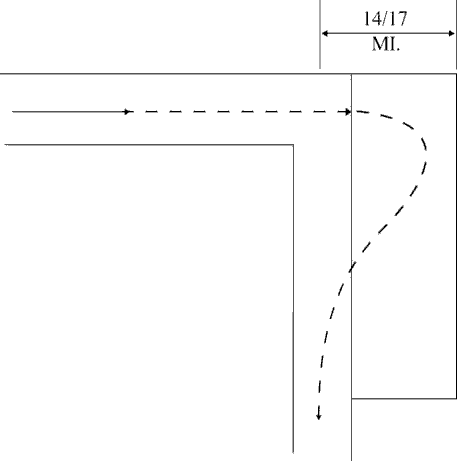
- Below FL 180- same as subparagraphs a1 or 2.
- FL 180 to FL 230 inclusive- 14 miles.
- Above FL230 to FL600 inclusive- 17miles.
- When course change is 91 degrees through 180 degrees, protect the airspace on the overflown side beginning at
the point where the course changes as follows: (See FIG 6-5-6.)
- Below FL 180- same as subparagraphs a1 or 2.
- FL 180 to FL 230 inclusive- 28 miles.
- Above FL230 to FL600 inclusive- 34miles.
FIG 6-5-6 Overflown Side Minima 91 to 180 Degrees 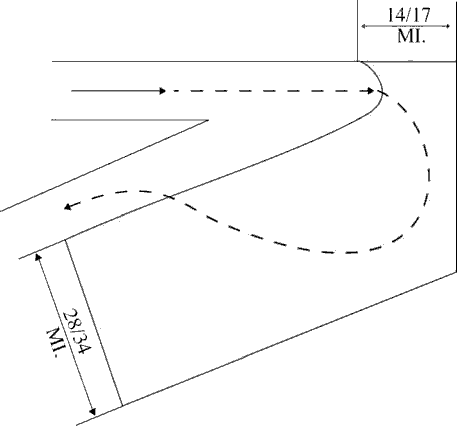
- After the course changes specified in subparagraphs b or c have been completed and the aircraft is back on course, the appropriate minima in subparagraph a may be used.

